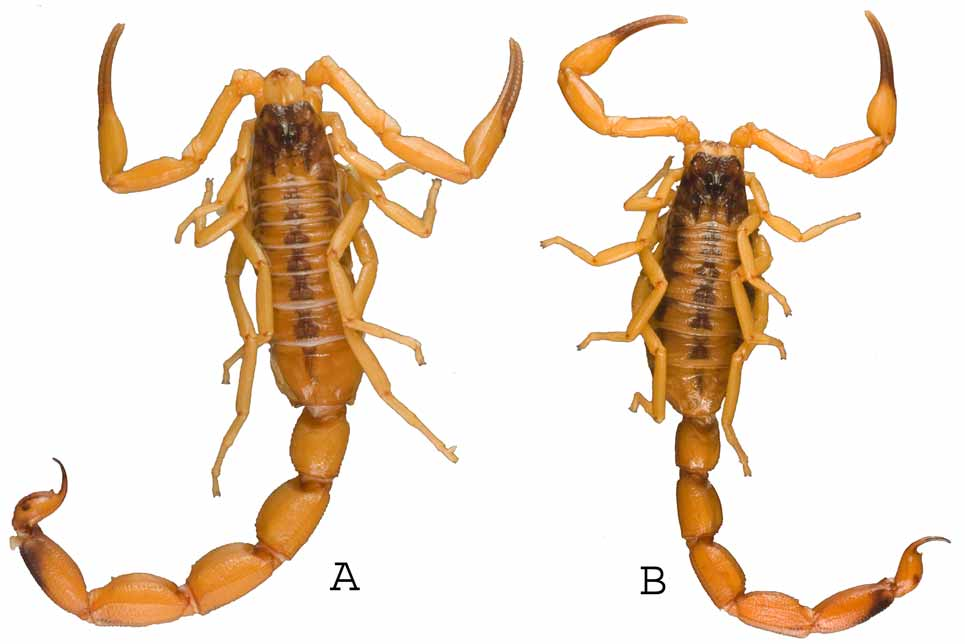Tityus aba [Candido, Lucas, de Souza, Diaz & Lira-da-Silva, 2005*]
Tityus aba Candido, Lucas, de Souza, Diaz & Lira-da-Silva, 2005*
Tityus aba Candido, Lucas, Souza, Dias & Lira-da-Silva, 2005
Tityus aba Candido, Lucas, Souza, Dias & Lira-da-Silva, 2005: 1–8, figs. 1–12, 13, table 1–2. Holotype % and paratype
& from Poções, Bahia, Brazil, (deposited in IBSP 3394 and 3395, examined). Souza et al, 2006: 28, 35; Lourenço,
2006: 60.
New record. Brazil, Bahia: Rio de Contas (Pico das Almas), 871m, 13º35’60’’S 41º47’60’’W, 11.IX.1991, M.
Trefaut U. Rodrigues leg., 1& (IBSP 2577).
Diagnosis. Male. This species differs from the others of complex by the presence of three dark brown
longitudinal stripes on tegites, except by T. martinpaechi and T. stigmurus. Tityus aba can be distinguished
from T. stigmurus by a different pattern of pigmentation, with carapace almost entire dark (Fig. 1A–B), three
longitudinal dark brown stripes on tergites which begin at the posterior edge of the carapace, the lateral ones
reaching the VI tergite and the central reaching the VII (Fig. 1A–B), a largest number of pectinal teeth (male
25–25, 26–25, 26–27) and greater total length (76,5 mm) (Candido et al, 2005), whereas T. stigmurus has a
single longitudinal dark brown stripe on tergites which reaching the VII tergite, carapace with only one trian-
gular dark brown spot on anterior region (Fig. 16A–B), small number of pectinal teeth (22, 23–24) and small-
est total length (60,3–63,8 mm). It also differs from T. martinpaechi by a different pattern of pigmentation,
without sparse dark brown spots on carapace, palps, legs, morphology of the palps and metasomal segments
which are slender (T. aba= femur: 8.3; tibia: 8.7; chela: 14.9; fig. 9A–B; T. martinpaechi= femur: 7.2; tibia:
7.4; chela: 13.3) and a largest number of pectinal teeth (T. martinpaechi: 22–21).
Female. Same color pattern as the male (Fig. 1A–B). Morphologically differing from the male, by the
shorter chela of the pedipalp (length female: 13.3mm; male: 14.9mm) (Fig. 2.A–B). Metasomal segments IV
and V longer and closer (IV: female 9.7mm and 4.5mm; male 9.3mm and 5.6mm—V: female 10.2mm and
4.2mm; male 9.3mm and 5.0mm) and total length (female 66.1mm and male 76.5mm) (Fig. 1A–B) (Candido
et al. 2005).
Distribution. State of Bahia, Brazil (Fig. 8).
REF-
On the Tityus stigmurus complex (Scorpiones, Buthidae)

 FIGURE 1. Tityus aba (% IBSP 3394 e & IBSP 3395; Poções, Bahia, Brazil). Male (A) and female (B) in dorsal view.
FIGURE 1. Tityus aba (% IBSP 3394 e & IBSP 3395; Poções, Bahia, Brazil). Male (A) and female (B) in dorsal view.
No Comments